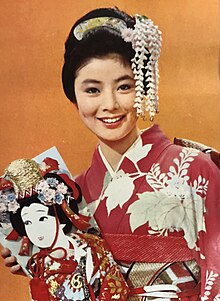Sumiko Fuji
Sumiko Fuji | |
|---|---|
 Sumiko Fuji (1965) | |
| Born | Junko Shundo ( December 1, 1945 Gobō, Wakayama, Japan |
| Other names | Junko Fuji |
| Occupation | Actress |
| Years active | 1963–present |
| Spouse | Onoe Kikugorō VII |
| Children | |
Junko Terashima (Japanese:
Early life and career
[edit]Fuji was born in Wakayama as the third child and younger daughter of future film producer Koji Shundo.[3] Her family eventually moved to Osaka, where, as a big fan of Takarazuka Revue, Fuji started to attend a dancing, singing and acting school during junior high.[3] At 17 her family moved to Kyoto, shortly after which her and her older sister Nobuko started to appear on the local TV show Hai Hai, Mahinadesu.[3] After visiting Toei's Kyoto studio, Fuji attracted the attention of director Masahiro Makino, who invited her to appear in one of his films. Although Shundo initially opposed his daughter entering show business, wanting a "normal" life for her instead, he acquiesced figuring it would be better she work for Toei instead of their rivals.[3]
In 1963, Fuji made her film debut in Makino's Hashu Yukyoden: Otoko no Sakazuki, and went on to appear in 10 movies that year while making regular appearances on NHK and TV Asahi television dramas.[3] Mark Schilling wrote that by the mid-1960s, Fuji was the leading actress for Toei, often playing the love interest for Kōji Tsuruta and Ken Takakura in Ninkyo eiga.[3] But she reached her peak in popularity between 1968 and 1972, starring as a sword-wielding gambler in the Hibotan Bakuto series of films.[3] In 1972, Fuji married a kabuki actor she met while making the NHK drama Minamoto no Yoshitsune.[3] After making Makino's Kanto Hizakura Ikka, she retired from acting that same year. Schilling wrote that the popularity of Ninkyo eiga subsequently declined, and a search for a successor failed.[3]
Selected filmography
[edit]Films
[edit]- 13 Assassins (1963)
- Hashu Yukyoden: Otoko no Sakazuki (
八 州 遊侠 伝 男 の盃 , 1963) - Bakumatsu Zankoku Monogatari (
幕末 残酷 物語 , 1964) - Onmitsu Kenshi (1964)
- Meiji Kyōkaku den: Sandaime Shūme (
明治 侠客 伝 三 代目 襲名 , 1965) - Bakuchiuchi Sōcho Tobaku (
博奕 打 ち総長 賭博 , 1968) - The Valiant Red Peony (1968)[4]
- Jinsei Gekijō: Hishakaku to Kiratsune (
人生 劇場 飛車 角 と吉良 常 , 1968) - Hibotan Bakuto: Hanafuda Shōbu (
緋牡丹 博徒 花札 勝負 , 1969) - Shōwa Zankyō den: Shinde Moraimasu (
昭和 残 侠伝死 んで貰 います, 1970) - Kanto Hizakura Ikka (
関東 緋 桜 一家 , 1972) - Chizuko's Younger Sister (1991)
- Wait and See (1998)
- The Geisha House (1999)
- Hula Girls (2006)
- The Inugamis (2006)
- Best Wishes for Tomorrow (2008)
- Air Doll (2009)
- Summer Wars (2009)
- Lady Maiko (2014)
- April Fools (2015)
- A Loving Husband (2017)
- Samurai's Promise (2018)
- Children of the Sea (2019), Dede (voice)[5]
- A Garden of Camellias (2021), Kinuko[6]
- DIVOC-12 (2021)[7]
Television
[edit]- Minamoto no Yoshitsune (1966) - Shizuka Gozen[8]
- Tobu ga Gotoku (1990) - Tenshōin
- Hōjō Tokimune (2001) - Matsushita Zen-ni[9]
- Tenchijin (2009) - Kōdai-in Nene[8]
- Teppan (2010–2011)[8]
- A Day-Off of Ryoma Takeuchi (2020)
Honours
[edit]- Kinuyo Tanaka Award (1999)[10]
- Medal with Purple Ribbon (2007)
- Order of the Rising Sun, 4th Class, Gold Rays with Rosette (2016)
References
[edit]- ^ "Burū Ribon Shō hisutorī 1999" (in Japanese). Cinema Hochi. Archived from the original on 20 July 2010. Retrieved 17 July 2010.
- ^ "Burū Ribon Shō hisutorī 2006" (in Japanese). Cinema Hochi. Archived from the original on 1 April 2014. Retrieved 17 July 2010.
- ^ a b c d e f g h i Schilling, Mark (2003). The Yakuza Movie Book : A Guide to Japanese Gangster Films. Stone Bridge Press. pp. 123–125. ISBN 1-880656-76-0.
- ^ "
緋牡丹 博徒 " (in Japanese). Motion Pictures Producers Association. Retrieved 11 December 2021. - ^ "
海獣 の子供 ". eiga.com. Retrieved October 3, 2022. - ^ "
椿 の庭 ". eiga.com. Retrieved October 3, 2022. - ^ "
富司 純子 、藤原 季 節 、蒔田 彩 珠 、中村 ゆり、前田 敦子 ら『DIVOC-12』第 1弾 キャスト発表 ". Real Sound. Retrieved April 30, 2021. - ^ a b c "
富司 純子 ". NHK. Retrieved October 3, 2022. - ^ "
北条 時宗 ". Haiyaku Jiten. Retrieved July 22, 2022. - ^ "
田中 絹代 賞 とは". Tanaka Kinuyo Memorial Association. Retrieved April 22, 2021.
External links
[edit]- Sumiko Fuji at IMDb
- Fuji Junko at the Japanese Movie Database (in Japanese)
